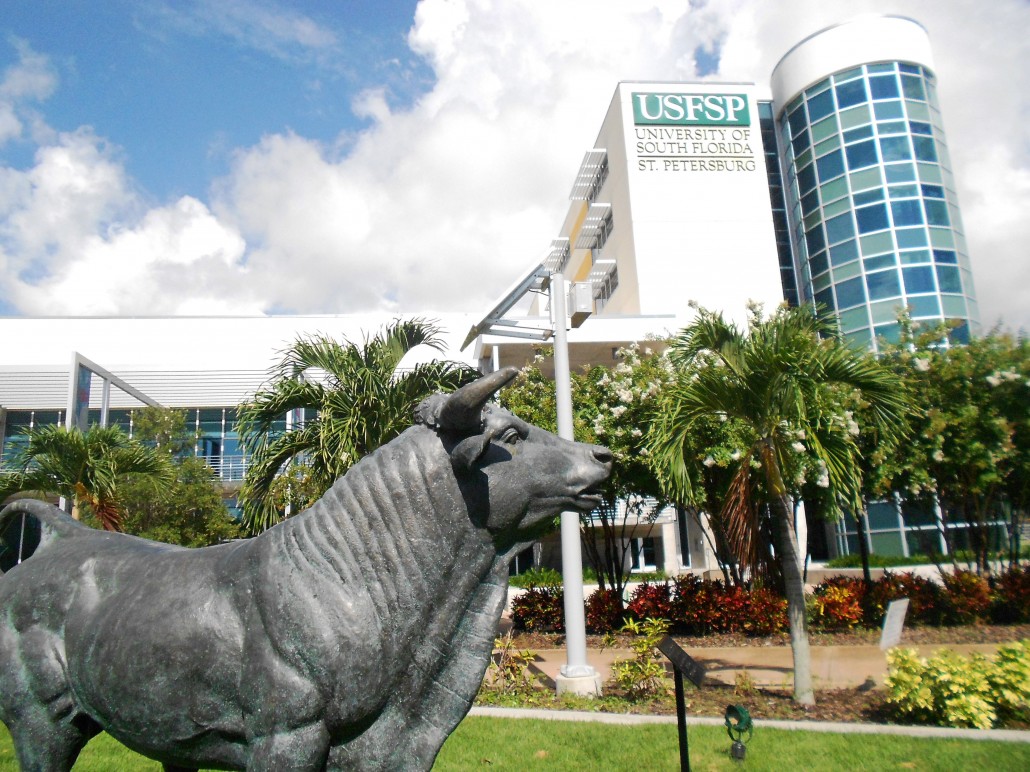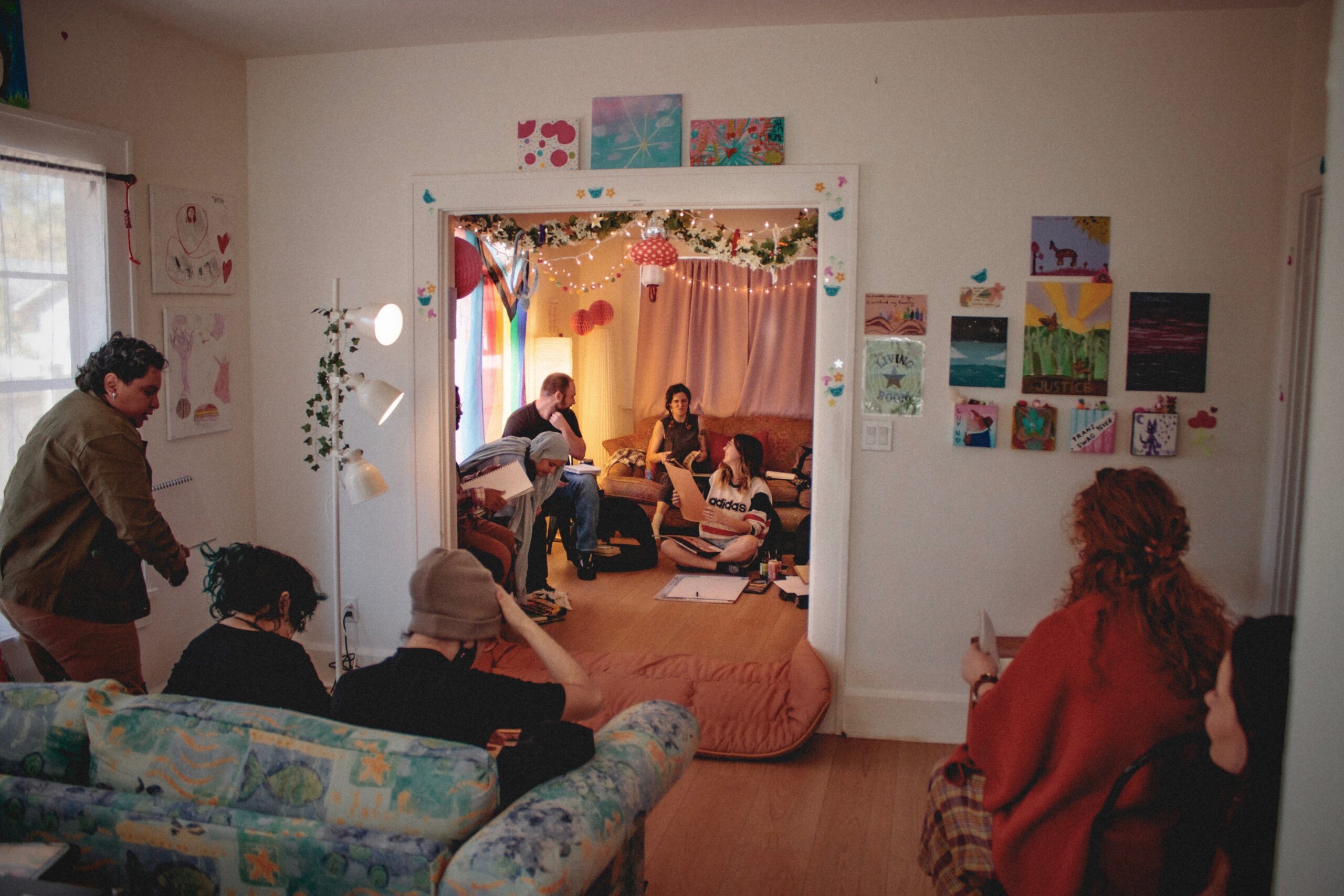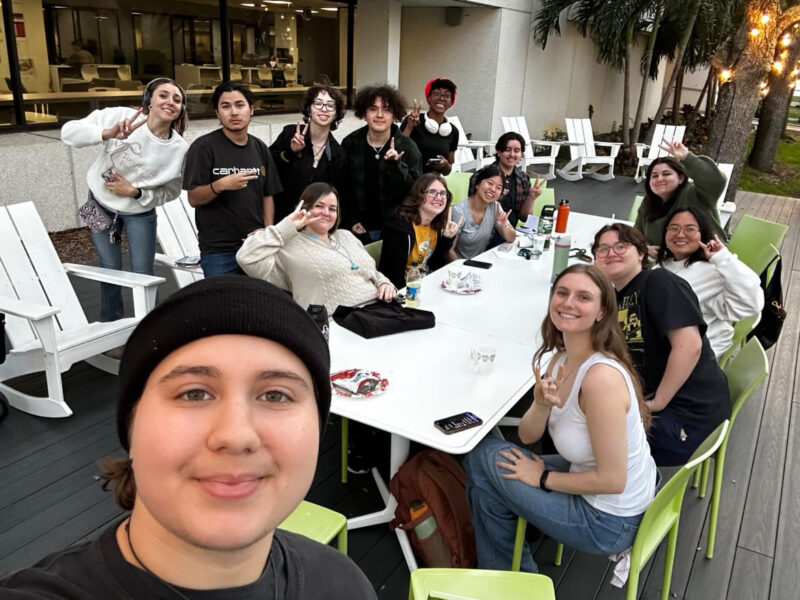Compiled from Crow’s Nest files; the work of historian James Anthony Schnur, the former special collections librarian at the Nelson Poynter Memorial Library; websites of USF St. Petersburg; the Tampa Bay Times; the Tampa Tribune; and “From Mangroves to Major League: A Timeline of St. Petersburg, Florida,” by Rick Baker.
Hi, freshmen and other newcomers. Welcome to USF St. Petersburg.
Bet you have lots of questions about the school that will be your home for the next few years. Here are the answers to some of them.
Why is a school in the west-central part of the state called the University of South Florida?
When the Florida Legislature authorized a new state university back in 1956, it became the southernmost university in the state. (The only universities back then were the University of Florida in Gainesville and Florida State and Florida A&M in Tallahassee). Legislators campaigning for a fourth university thought the name South Florida would help get the support of legislators in the southern part of the state. They were right.
How did Tampa become the site of the main campus of USF? Why not St. Petersburg?
Civic leaders in St. Petersburg and the St. Petersburg Times lobbied hard to get the campus here. But Tampa, which was bigger than St. Petersburg, had more clout in the state capital. St. Petersburg had to settle for a branch campus, which opened for students in 1965.
How big is our campus, and what used to be here?
The campus now has 29 buildings on 52 acres, but for years it was confined to 11.8 acres on a finger of land that juts out into Bayboro Harbor. Today that finger is home to the USF College of Marine Science, the state Fish and Wildlife Conservation Commission and our swimming pool. The first campus buildings in 1965 had housed the U.S. Maritime Service Training Station from 1939 to 1950 and then the provisional campus of Florida Presbyterian College (now Eckerd College) from 1959 until it moved to its present location near the Sunshine Skyway in 1963.
What is the relationship between USF Tampa and USF St. Petersburg?
With approximately 42,800 students (in 2016-2017), USF Tampa is much bigger. But USFSP (4,700 students) is way cooler. Those campuses, along with USF Sarasota-Manatee (2,100 students), are part of the USF system, which is run by president Judy Genshaft (who is based in Tampa) and a 13-member Board of Trustees.
Does that make USFSP a red-headed stepchild?
Sometimes it seems like it. But it is important to note that both USF St. Petersburg and USF Sarasota-Manatee are separately accredited by the Southern Association of Colleges and Schools Commission on Colleges. That’s a big deal in academic governance and gives the two campuses a lot of freedom. And there’s this: Our waterfront campus is beautiful – and just a short walk from a hip downtown. Take that, Tampa!
Who runs USF St. Petersburg?
As regional chancellor, Dr. Sophia Wisniewska is the university’s chief executive officer. She reports to USF system president Genshaft in Tampa and to a five-member Campus Board – all residents of Pinellas County.
How do you pronounce Wisniewska?
It’s wiz-NES-kuh (and, yes, she’s used to people butchering it). She was born in a small Polish town, grew up in Philadelphia and became the first member of her family to graduate from college. She is a scholar of Russian language and literature and came to USFSP in July 2013 from Penn State Brandywine, where she was chancellor for eight years. If you’d like to chat her up, mention Pink Floyd. She’s a big fan.
How many academic colleges are on campus?
There are three: The College of Arts and Sciences (which had 1,608 undergrads and graduate students in 2016-2017), the College of Business (1,195) and the College of Education (314). The College of Marine Science (106 grad students) is also here, but it is an academic unit of USF Tampa.
Does our campus have a student government?
Yes. It consists of an executive cabinet led by President David Thompson, a legislative body called the senate, and a supreme court. Student Government elections are held in the fall and again in the spring, and voter turnout is usually poor. That’s unfortunate. Student Government helps decide how to spend the $3.3 million that is raised annually through students’ activities and service fees. For 2017-2018 Student Government has a budget of $199,054.
Where does The Crow’s Nest staff get the money to publish a website and weekly newspaper?
The $48,387 in the paper’s budget comes from students’ activities and service fees in a budget set by Student Government.
What’s the story behind the statue of a bull on Harbor Walk in front of the University Student Center?
The 850-pound bronze statue was installed by Student Government in February 2013. The cost? About $10,000. It’s said to be anatomically correct, if you care to check.
How many students have had their photos snapped alongside (or atop) the bull?
Must be thousands by now.
How did the bull become the USF mascot?
Since cattle-raising was important in Florida, the “Golden Brahman” was selected in 1962. By the late 1980s, that had evolved into the Bulls. Rocky the Bull was first trademarked in 1974. And the “Go Bulls” hand signal – with the index and pinky fingers extended upward, like horns – apparently started as a good luck gesture for free-throw shots at basketball games on the Tampa campus.
Are there sports teams on our campus?
There are intramural and club sports here, but the only intercollegiate sport is the sailing team, which is a member of the South Atlantic Intercollegiate Sailing Association. The administration is mulling the possibility of adding more sports teams as the campus grows. Each student here pays an athletic fee – now $34.40 for a full-time student taking 12 credit hours – and some of that helps fund the intercollegiate sports program on the Tampa campus.
What are those tall buildings a block or two west of the campus?
The cluster of buildings includes Bayfront Health St. Petersburg, a 110-year-old, 480-bed hospital, and Johns Hopkins All Children’s Hospital, a 91-year-old, 259-bed facility that serves children throughout west-central Florida. Under construction nearby is a seven-story research and education building where doctors, scientists and medical students from All Children’s and USF Health will collaborate on pediatric research.
What else is over that way?
More buildings with lots of brain power, including the National Oceanic and Atmospheric Administration and the U.S. Geological Survey – which work closely with the College of Marine Science on our campus – and the Poynter Institute for Media Studies, which owns the Tampa Bay Times and trains journalists all over the world. The city has a name for this confluence of educational institutions, hospitals and marine research outfits – the “Innovation District.”
What’s the story on the nearby airport? Some of the planes that take off and land there seem to come awfully close to the tops of campus buildings.
That’s Albert Whitted Airport, which has been around since 1929 – far longer than our campus and most of the institutions in St. Petersburg. Because part of the campus lies beneath the flight path of the main runway the height of our buildings is limited. City codes, Florida law and rules of the Federal Aviation Commission don’t allow tall buildings.
Who was Albert Whitted?
He was a St. Petersburg native and aviation pioneer who was killed in a plane crash near Pensacola in 1923. The airport bearing his name has made national news over the years. It was once home to one of America’s first airline companies (National Airlines) and to one of the famous Goodyear blimps. In 1985, a retired couple from Chicago got lost, mistook one of the runways for Interstate 275 and drove off the seawall into Tampa Bay. They were quickly fished out of neck-deep water, unharmed, by firefighters who happened to be training nearby.
What’s the fancy glass building just northeast of campus?
That’s the Salvador Dali Museum, which features the largest collection of the eccentric artist’s work outside of Europe. The stunning building has a warped geodesic wave composed of more than a thousand glass triangles that is called the “glass enigma.” The Dali, which has drawn millions of visitors from around the world, is one of several museums that help make St. Petersburg a mecca for artists and art lovers.
What else does downtown St. Petersburg have to offer college students and millennials?
Where to start? Try trendy restaurants and bars, craft beer places, entertainment venues, hip shops and tattoo parlors. Earlier this month, the city even hosted the annual convention of Fetish Con, which brought thousands of people who are into kinky stuff like costumes, cross-dressing and bondage. (No admittance to people under 18.)
Has the city always been this hip?
Hardly. For decades, national magazines and TV comedians derided St. Petersburg as “God’s waiting room” and the “city of green benches” – a place where hordes of seniors shared the downtown sidewalks with pigeons.
What happened?
A happy confluence of stuff. The Vinoy Hotel, which had been closed for 18 years, was lovingly restored and became a crown jewel of downtown. A now-defunct international museum brought thousands of visitors downtown and spawned a bunch of lunch spots. Major League Baseball arrived in 1998, and on-again-off-again auto street racing, which began in 1985, morphed into a high-profile Grand Prix race in 2005 that draws an estimated 140,000 fans (and makes a lot of racket) each spring. The 1990s brought stirrings of an art renaissance that is still snowballing, and numerous condo and department towers have been built, with more on the way.
What’s the story on the sports stadium three blocks north of campus?
That’s Al Lang Stadium, which since 2011 has been the home of Tampa Bay’s professional soccer team, the Rowdies. The stadium is better known as a longtime home for Major League Baseball spring training. It’s named for a former mayor who persuaded the first team – the St. Louis Browns – to train here in 1914. Over the years, seven teams trained at Al Lang and its predecessor, Waterfront Park. Among them were the St. Louis Cardinals (think Stan Musial); the New York Yankees (Babe Ruth, Joe DiMaggio and Mickey Mantle); and the Tampa Bay Devil Rays (now called the Rays).
Babe Ruth played in St. Petersburg?
Yes, and “played” is the right verb. Nobody enjoyed the city more than the Bambino. He played golf, fished in the gulf, frequented the dog track, visited sick kids in the hospital, partied with the ladies and drank gallons of Prohibition-era hooch.
Header photo courtesy of USF St. Petersburg Housing & Residence Life



